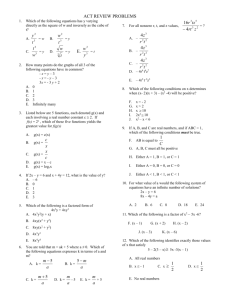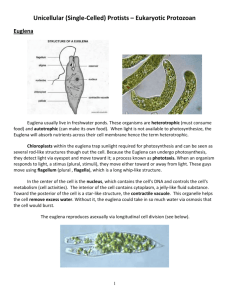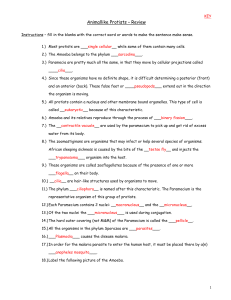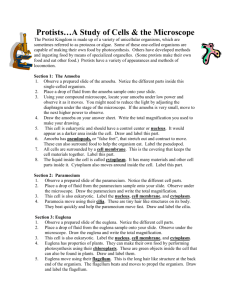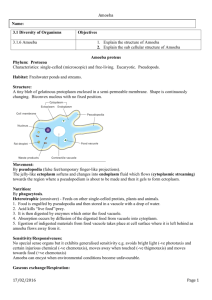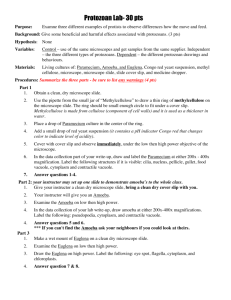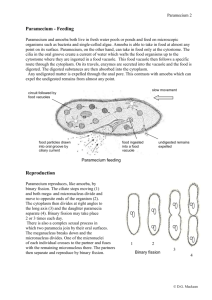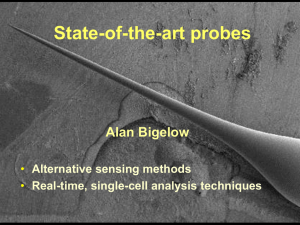observations on amoeba feeding on the ciliate frontonia.
advertisement
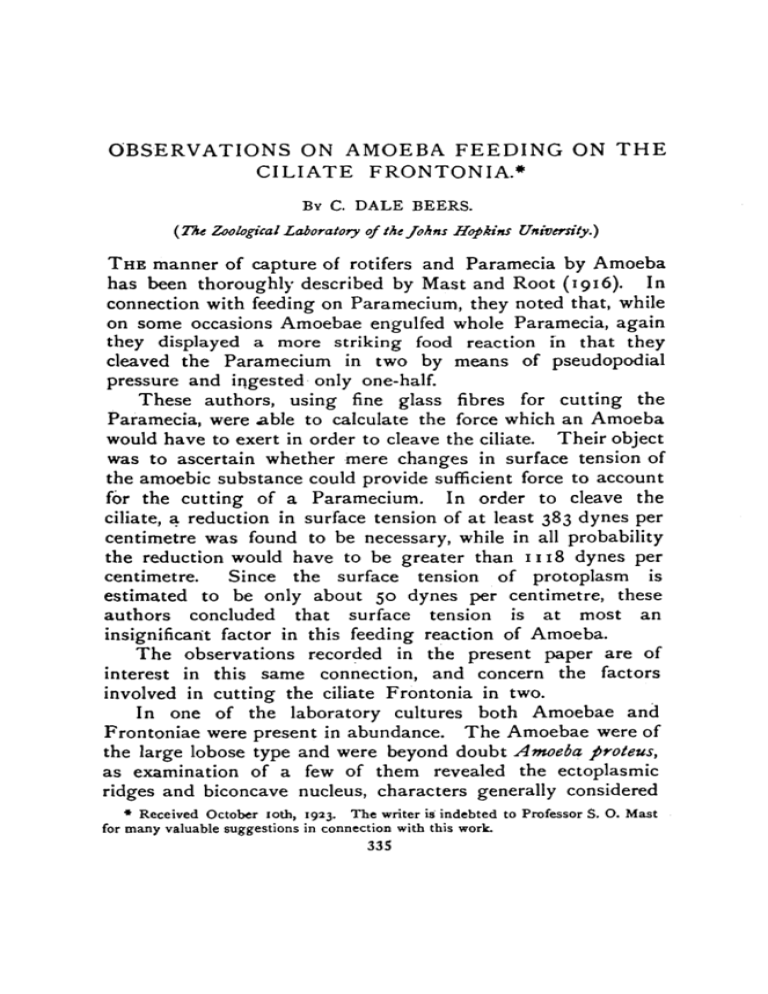
OBSERVATIONS ON AMOEBA FEEDING ON THE CILIATE FRONTONIA.* BY C. DALE BEERS. (The Zoological Laboratory of the Johns Hopkins University.) T H E manner of capture of rotifers and Paramecia by Amoeba has been thoroughly described by Mast and Root (1916). In connection with feeding on Paramecium, they noted that, while on some occasions Amoebae engulfed whole Paramecia, again they displayed a more striking food reaction fn that they cleaved the Paramecium in two by means of pseudopodial pressure and ingested only one-half. These authors, using fine glass fibres for cutting the Paramecia, were able to calculate the force which an Amoeba would have to exert in order to cleave the ciliate. Their object was to ascertain whether mere changes in surface tension of the amoebic substance could provide sufficient force to account for the cutting of a Paramecium. In order to cleave the ciliate, a reduction in surface tension of at least 383 dynes per centimetre was found to be necessary, while in all probability the reduction would have to be greater than 1118 dynes per centimetre. Since the surface tension of protoplasm is estimated to be only about 50 dynes per centimetre, these authors concluded that surface tension is at most an insignificant factor in this feeding reaction of Amoeba. The observations recorded in the present paper are of interest in this same connection, and concern the factors involved in cutting the ciliate Frontonia in two. In one of the laboratory cultures both Amoebae and Frontoniae were present in abundance. The Amoebae were of the large lobose type and were beyond doubt Amoeba proteus, as examination of a few of them revealed the ectoplasmic ridges and biconcave nucleus, characters generally considered • Received October ioth, 1923. The writer is indebted to Professor S. O. Mast for many valuable suggestions in connection with this work. 33S C. Dale Beers to be specific for A. proteus. In length the Frontoniae measured some 250 M, and corresponded to the descriptions of F. leucas. It is only rarely that Frontoniae flourish in hay infusion cultures, though in certain cultures containing much bacterial zoogloea and decaying organic matter, they fare exceedingly well. On numerous occasions they were seen to feed on this organic debris. On account of this food, they were distinctly black, and not hyaline or greenish as when feeding in open pools on algae and the like. Moreover, they were consistently symmetrical in form, never being distorted by contained food. On one occasion upon examining this culture with a dissecting binocular, an Amoeba was observed which had partially engulfed a Frontonia (fig. 1, A). By means of pseudopodial pressure, the Amoeba had constricted the middle region of the Frontonia until the latter was forced into the shape of a dumb-bell. One half of the Frontonia was enclosed by the pseudopods of the Amoeba, the other half was free. When first observed the ciliate was making desperate attempts at escape, and was dragging the Amoeba here and there about the bottom of the culture. Both organisms were immediately transferred to a depression slide in a large drop of culture fluid and there observed under the microscope. For some moments the Amoeba was carried around by the actively moving ciliate. During this interval opportunity was afforded to note that from all appearances the constriction in the middle region of the Frontonia was not the result of pressure exerted by two apposed pseudopods of the Amoeba, but was due to centripetal pressure exercised by a closed collar of amoebic protoplasm. Later the Amoeba became attached to the slide and continued the process of ingestion (fig. 1, A). It seemed likely that the pseudopodial ring of the Amoeba would continue its centripetal compression and constrict the captured Frontonia in two, the proximal or engulfed end becoming simultaneously enclosed in a food vacuole and the distal or free half escaping. However, the process of cleaving ended when constriction had progressed as far as is indicated in fig. 1, A, the manner of procedure of the Amoeba being then altered. While the body of the Amoeba, 336 Amoeba Feeding on the Ciliate Frontonia F FIG. I.—Successive free-hand sketches showing an Amoeba cleaving a captured Frontonia in half and ingesting one-half. Arrows indicate the direction of movement of the pseudopodial collar of the Amoeba. The sketches were made at intervals of about one minute and a half: a, Amoeba attached to substratum ; t, engulfed half of Frontonia; / free half of Frontonia ; «, middle region of Frontonia constricted into the shape of a strand connecting the halves; / , pseudopodial collar of Amoeba; i, portion of interconnecting strand attached to free half. A. The middle region of the Froatonia is markedly constricted by the pseudopodial coHar or cup of the Amoeba. B. The collar of amoebic protoplasm is flowing in the direction of the free half of the Frontonia, thus pushing the halves farther apart and stretching the constricted interconnecting portion. C-D. The pressure of the pseudopodial collar is pressing the free half of the ciliate into a spherical shape and stretching the strand until it shows signs of breaking in one excessively narrowed region. E. The strand has parted ; the protoplasmic collar of the Amoeba is being retracted. F. The elasticity of the free half is bringing it back to the normal shape. pseudopodial collar is nearly retracted. 337 The C. Dale Beers firmly attached to the substratum, held fast to the proximal half of the ciliate, the collar of protoplasm, still exerting sufficient centripetal pressure to keep the middle region of the Frontonia constricted, began to flow in the direction of the free end of the ciliate (fig. i, B}, thus elongating the strand which connected the halves and forcing the free half to approach the shape of a sphere. As the protoplasmic collar continued to flow distally, this half became nearly spherical (fig. i, C), while the interconnecting strand became continuously longer, and showed indications of breaking in one excessively narrowed region (fig. i, D). In fact, it was in this narrowed region that the strand parted a moment later (fig. i, E), its severance, and the consequent separation of the ciliate into halves, marking the completion of the process of ingestion. Following the separation of the halves, the pseudopodial collar of the Amoeba was gradually retracted (fig. i, E and F). As the pressure was removed from the free half of the Frontonia, this half ceased to be globular, and more nearly assumed the normal shape, though a portion of the attenuated interconnecting strand still remained attached to it at the base (fig. i, E and F). As the protoplasmic collar continued to be retracted, this free half gradually slipped out of the depression in which it was held by its attenuated part and swam about erratically for some time (fig. r, E and F). The half ingested by the Amoeba formed a large, slightly irregular food vacuole of a distinctly black colour. The process, from the time of attachment of the Amoeba to the complete retraction of the pseudopodial collar, required about eight minutes. Following these observations, the culture was examined again to see if other Amoebae were feeding on Frontoniae. Though no additional instances were noted at the time several Amoebae, each containing a large black food vacuole, were noticed. It appears certain that these vacuoles resulted from the ingestion of Frontoniae, for vacuoles produced by the ingestion of any other creature in the culture, whether Paramecium, rotifer, or flagellate, or bacterial zooglcea, were always much lighter in colour. This culture was frequently observed, and while the characteristic black food vacuoles were noted on several 338 Amoeba Feeding on the Ciliate Frontonia occasions, an actual repetition of the feeding phenomenon was not witnessed for an interval of nearly three weeks, when a casual examination disclosed an Amoeba attached to the bottom and holding a captured Frontonia as before. Camera lucida drawings were made showing different stages in the process (fig. 2, A-E). These figures agree in all respects with the FlG. 2.—Successive camera lucida sketches for comparison with the free-hand sketches of fig. I, made at intervals of two minutes showing a second case of Amoeba cutting Frontonia in half. In the process the Frontonia was stretched from • length of 250 n (A~) to a length of 310 p (Cy. Labelling as in fig. I. free-hand sketches (fig. i, A-F) made in the first instance, and show clearly that by means of longitudinal pressure exerted by the pseudopodial collar of the Amoeba, the halves of the Frontonia were continuously pushed farther apart until the severance of the interconnecting portion occurred. In both cases the pseudopodial collar of the Amoeba was distinctly hyaline in character, containing only small granules and having the appearance generally characteristic of the ectosarc. 339 C. Dale Beers Digestion of the engulfed halves of Frontonia appeared to progress at a very slow rate. The first Amoeba isolated following ingestion retained the vacuole for nearly four days. The second Amoeba retained its vacuole three days. Greenwood (1887) and Mast and Root (1916) have noted that vacuoles containing rotifers may be retained for three days with incomplete digestion at the end of that time. The feeding of Amoeba on Frontonia is of especial interest when considered in the light of the surface tension theory as generally interpreted, i.e. the idea that the varied activities of Amoeba are brought about entirely by changes in surface tension of the amoebic substance. That surface tension could provide sufficient force to enable Amoeba to compress so turgid an organism as Frontonia, appears impossible. Moreover, surface tension in no wise explains the manner in which Amoeba is enabled to maintain its hold on Frontonia, while being dragged about in the debris of the culture by its captive. Nor does it appear rational to conclude that the force which the protoplasmic collar exerts in ultimately cleaving the Frontonia could possibly result from changes in surface tension. The force of the collar of amoebic protoplasm not only stretches the interconnecting portion out to a relatively great length, but in so doing presses the distal half of the ciliate into the shape of a sphere (fig. 1, C and D; fig. 2, C). It is significant to recall that when the pressure is removed this half still displays sufficient elasticity to return partially or entirely to the normal shape (fig. I, F";fig.2, £). Furthermore, while the Amoeba is stretching the Frontonia, it is obvious that the protoplasmic collar is exerting an appreciable centripetal pressure, else the middle region of the Frontonia would not preserve the shape of an elongated strand. In this regard it is well to call attention to the variety of shapes assumed by the engulfed half, for in each of the accompanying sets of figures the shape of this half is different. Clearly these different shapes are the result of varying pressures exerted over the surface of the engulfed half by the Amoeba. Whether surface tension could furnish sufficient force to hold and thus compress the engulfed half, is highly questionable. The process of ingesting a half Frontonia, therefore, appears 34° Amoeba Feeding on the Ciliate Frontonia to be of a degree of complexity which the surface tension theory is inadequate to explain ; the mechanics of the process no doubt involves a number of co-operating factors, such as cohesion, and gelation and solation pressures (Mast, 1923). Summary. 1. Amoeba occasionally feeds on the ciliate Frontonia. 2. In the instances of feeding observed, the Frontonia was not ingested whole but was cut in half by the Amoeba. 3. One half of the Frontonia is engulfed in a food cup of the Amoeba, the pseudopods of the cup producing an annular constriction in the middle region of the ciliate. 4. The pseudopodial collar or cup flows distally and presses against the free half of the Frontonia. Thus the halves are pushed continuously farther apart, until the attenuated interconnecting strand is severed and one-half of the Frontonia is simultaneously engulfed. References. Greenwood, M. (1887), "On the Digestive Process in Some Rhizopods,"/(W/7z. Phys., 8, 263-87. Mast, S. O., and Root, F. M. (1916), "Observations on Amceba feeding on Rotifers, Nematodes, and Ciliates, and their Bearing on the Surface-Tension Theory," Journ. Exp. Zool., 21, 33-49, Mast, S. O. (1923), "Mechanics of Locomotion in Amoeba," Proc. Nat. Acad. Set'., 9, No. 7, 358-61. VOL. 1.—NO. 3. 341
